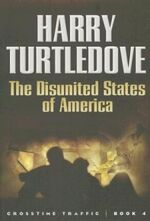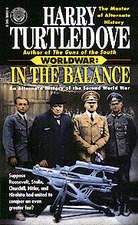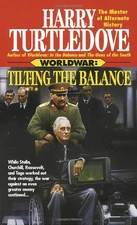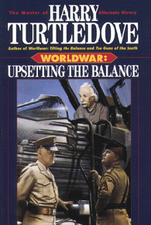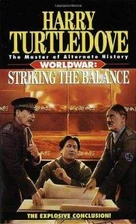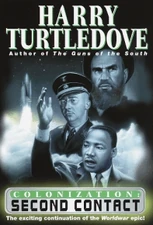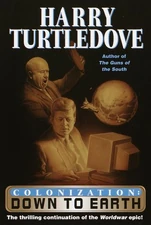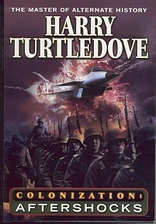TR (Message Wall | contribs) Tag: rte-wysiwyg |
TR (Message Wall | contribs) Tag: rte-wysiwyg |
||
| Line 20: | Line 20: | ||
'''Texas''' had been an area that had been colonized by the [[United States (Southern Victory)|United States]], but was under the government of [[Mexico (Southern Victory)|Mexico]]. They rebelled in 1835, which in turn, ignited the [[Mexican War]], resulting in the short lived, '''Republic of Texas''', and the eventual annexation into the United States. Barely a generation later, Texas was at war again, when she voted to leave the Union, although governor [[Sam Houston#Sam Houston in Southern Victory|Sam Houston]] attempted to prevent this, he was unsuccessful. Throughout the war, Texas was a quiet front, and the only major action was the [[New Mexico Campaign|ill-fated expedition]] into the [[New Mexico (Southern Victory)|New Mexico Territory]]. In the aftermath of the [[War of Secession]], Texas represented the very edge of the [[Confederate States (Southern Victory)|Confederacy]], until 1881, when the CS Government under the presidency of [[James Longstreet (Southern Victory)|James Longstreet]], acquired the Mexican provinces of [[Sonora (Southern Victory)|Sonora]] and [[Chihuahua (Southern Victory)|Chihuahua]], thus extending the border all the way to the [[Pacific Ocean]]. While this ignited the [[Second Mexican War]], Texas saw no action as all major conflicts were limited to the new Confederate territories. After the war ended, the Confederacy's transcontinental railroad ran through the state as it connected both the Pacific and the [[Atlantic Ocean|Atlantic]]. |
'''Texas''' had been an area that had been colonized by the [[United States (Southern Victory)|United States]], but was under the government of [[Mexico (Southern Victory)|Mexico]]. They rebelled in 1835, which in turn, ignited the [[Mexican War]], resulting in the short lived, '''Republic of Texas''', and the eventual annexation into the United States. Barely a generation later, Texas was at war again, when she voted to leave the Union, although governor [[Sam Houston#Sam Houston in Southern Victory|Sam Houston]] attempted to prevent this, he was unsuccessful. Throughout the war, Texas was a quiet front, and the only major action was the [[New Mexico Campaign|ill-fated expedition]] into the [[New Mexico (Southern Victory)|New Mexico Territory]]. In the aftermath of the [[War of Secession]], Texas represented the very edge of the [[Confederate States (Southern Victory)|Confederacy]], until 1881, when the CS Government under the presidency of [[James Longstreet (Southern Victory)|James Longstreet]], acquired the Mexican provinces of [[Sonora (Southern Victory)|Sonora]] and [[Chihuahua (Southern Victory)|Chihuahua]], thus extending the border all the way to the [[Pacific Ocean]]. While this ignited the [[Second Mexican War]], Texas saw no action as all major conflicts were limited to the new Confederate territories. After the war ended, the Confederacy's transcontinental railroad ran through the state as it connected both the Pacific and the [[Atlantic Ocean|Atlantic]]. |
||
| − | + | When the [[Great War (Southern Victory)|Great War]] consumed the [[North America (Southern Victory)|North American]] continent, Texas was a front. Warfare out on the Texas prairies was scattered without the bloodshed of trench warfare back east, but the Union still held the upper hand, driving the [[Confederate States Army (Southern Victory)|Confederate Army]] back into the state. In 1917, the US Army had captured enough territory with enough sympathizers that it was able to establish the new US State of [[Houston (state)|Houston]] (named in honor of the late [[Sam Houston#Sam Houston in Southern Victory|Sam Houston]]; ironically, the city of [[Houston, Texas#Houston in Southern Victory|Houston]] was not a part of the new US State). After peace was declared, Texas, like the rest of the country, suffered a national trauma from both the loss of the war and the creation of the US state of Houston, which all Confederates referred to as "West Texas". Although Texas oil companies were thriving from the loss of [[Sequoyah]] and its oil deposits, the country was forced to pay huge reparations to the US, including as much oil as they could, crippling the economy. This in turn lead to the rise of the right wing political party, the [[Redemption League]]. However, the [[Freedom Party]] was successful in opening at least one chapter in Texas and eventually absorbing the Redemption League. When the Freedom Party took the reigns of power within the Confederacy, agitators were stirred up within the US state of Houston with Confederate weapons and party ideology. This caused so many problems for the United States that in 1940, a [[Richmond Agreement Plebiscite|plebiscite]] was called for as part of the [[Richmond Agreement]]. A strong majority voted for the return of Houston to Texas, which took place the following year.. |
|
| − | The Second Great War began North American in June 1941. The Freedom Party established [[Camp Determination]] within Texas for its [[Population Reduction|Population Reduction Program]]. During 1942-43, the camp was the target for the [[11th Army|US Eleventh Army]] under the leadership of Major General [[Abner Dowling]]. This resulted in a static war of attacks and counter-attacks by the elite [[Freedom Party Guards|Freedom Party Guard]]. By 1944, as the US 11th Army advanced past [[Lubbock]], the United States re-admitted the State of Houston into the Union, much to the chagrin of the locals. With the US Army running roughshod over the state and the US on the road to a total victory in the war, Texas Governor Wright Patman announced Texas's secession from the CSA, with himself as the president of a new republic. Patman concluded a separate peace agreement with the US. As part of that agreement, the [[Texas Rangers#Texas Rangers in Southern Victory|Texas Rangers]] immediately rounded up all the senior members of the Freedom Party located within its borders, including [[Jefferson Pinkard]]. |
+ | The Second Great War began North American in June 1941. The Freedom Party established [[Camp Determination]] within Texas for its [[Population Reduction|Population Reduction Program]]. During 1942-43, the camp was the target for the [[11th Army|US Eleventh Army]] under the leadership of Major General [[Abner Dowling]]. This resulted in a static war of attacks and counter-attacks by the elite [[Freedom Party Guards|Freedom Party Guard]]. By 1944, as the US 11th Army advanced past [[Lubbock]], the United States re-admitted the State of Houston into the Union, much to the chagrin of the locals. With the US Army running roughshod over the state and the US on the road to a total victory in the war, Texas Governor [[Wright Patman#Wright Patman in Southern Victory|Wright Patman]] announced Texas's secession from the CSA, with himself as the president of a new republic. Patman concluded a separate peace agreement with the US. As part of that agreement, the [[Texas Rangers#Texas Rangers in Southern Victory|Texas Rangers]] immediately rounded up all the senior members of the Freedom Party located within its borders, including [[Jefferson Pinkard]]. |
While the US recognized Texas as a republic for the duration of the Second Great War and its immediate aftermath, US officials privately doubted that Texas would remain independent. |
While the US recognized Texas as a republic for the duration of the Second Great War and its immediate aftermath, US officials privately doubted that Texas would remain independent. |
||
Revision as of 16:01, 4 July 2015
For the city in Maryland, see Texas, Maryland.
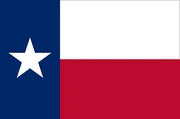
Flag of Texas, which flew during its brief stint as an independent republic and during its time as a state in both the US and the CS.
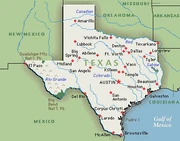
Texas is a state located in the southern and southwestern regions of the United States of America. It is the second largest state in terms of both area and population.
Texas declared its independence from Mexico in 1836 and existed as the independent Republic of Texas for nearly a decade. In 1845, it joined the United States as the 28th state. It joined the Confederate States in 1861, and returned to the Union after the American Civil War.
Texas saw a major economical boom throughout the 20th century, based largely on its substantial oil resources. This in turn drove the creation of a formidable high-tech industry.
Texas in Joe Steele
Texas was the home of President Joe Steele's Vice President (and would-be successor), John Nance Garner. Sam Rayburn, one of Steele's early opponents, also hailed from Texas.
Texas in "Lee at the Alamo"
Texas seceded from the United States in February, 1861, despite the best efforts of Governor Sam Houston. However, when members of the Texas militia under the command of Colonel Ben McCulloch attempted to seize U.S. property and material from the United States Army Department of Texas in San Antonio, they were met with resistence from Lt. Colonel Robert E. Lee, who retreated into the Alamo, and made a stand until March. This second battle of the Alamo was the first battle of the American Civil War.
Texas in "Secret Names"
Eestexas was a region in the eastern part of the former state of Texas where tribes of hunter-gathers resided some two hundred years after the world wide calamity called the Big Oops. To the east were the clans of the KayJun hunter-gathers while to the south and west were the Makykanoes. The Eestexians spoke English while the Makykanoes spoke Spanyol and the KayJuns spoke a third language.
Texas in Southern Victory
Texas had been an area that had been colonized by the United States, but was under the government of Mexico. They rebelled in 1835, which in turn, ignited the Mexican War, resulting in the short lived, Republic of Texas, and the eventual annexation into the United States. Barely a generation later, Texas was at war again, when she voted to leave the Union, although governor Sam Houston attempted to prevent this, he was unsuccessful. Throughout the war, Texas was a quiet front, and the only major action was the ill-fated expedition into the New Mexico Territory. In the aftermath of the War of Secession, Texas represented the very edge of the Confederacy, until 1881, when the CS Government under the presidency of James Longstreet, acquired the Mexican provinces of Sonora and Chihuahua, thus extending the border all the way to the Pacific Ocean. While this ignited the Second Mexican War, Texas saw no action as all major conflicts were limited to the new Confederate territories. After the war ended, the Confederacy's transcontinental railroad ran through the state as it connected both the Pacific and the Atlantic.
When the Great War consumed the North American continent, Texas was a front. Warfare out on the Texas prairies was scattered without the bloodshed of trench warfare back east, but the Union still held the upper hand, driving the Confederate Army back into the state. In 1917, the US Army had captured enough territory with enough sympathizers that it was able to establish the new US State of Houston (named in honor of the late Sam Houston; ironically, the city of Houston was not a part of the new US State). After peace was declared, Texas, like the rest of the country, suffered a national trauma from both the loss of the war and the creation of the US state of Houston, which all Confederates referred to as "West Texas". Although Texas oil companies were thriving from the loss of Sequoyah and its oil deposits, the country was forced to pay huge reparations to the US, including as much oil as they could, crippling the economy. This in turn lead to the rise of the right wing political party, the Redemption League. However, the Freedom Party was successful in opening at least one chapter in Texas and eventually absorbing the Redemption League. When the Freedom Party took the reigns of power within the Confederacy, agitators were stirred up within the US state of Houston with Confederate weapons and party ideology. This caused so many problems for the United States that in 1940, a plebiscite was called for as part of the Richmond Agreement. A strong majority voted for the return of Houston to Texas, which took place the following year..
The Second Great War began North American in June 1941. The Freedom Party established Camp Determination within Texas for its Population Reduction Program. During 1942-43, the camp was the target for the US Eleventh Army under the leadership of Major General Abner Dowling. This resulted in a static war of attacks and counter-attacks by the elite Freedom Party Guard. By 1944, as the US 11th Army advanced past Lubbock, the United States re-admitted the State of Houston into the Union, much to the chagrin of the locals. With the US Army running roughshod over the state and the US on the road to a total victory in the war, Texas Governor Wright Patman announced Texas's secession from the CSA, with himself as the president of a new republic. Patman concluded a separate peace agreement with the US. As part of that agreement, the Texas Rangers immediately rounded up all the senior members of the Freedom Party located within its borders, including Jefferson Pinkard.
While the US recognized Texas as a republic for the duration of the Second Great War and its immediate aftermath, US officials privately doubted that Texas would remain independent.
Ill-fated Vice President and former leader of the Redemption League Willy Knight hailed from Texas.
Texas in Supervolcano
The Yellowstone Supervolcano eruption was so powerful that there was volcanic ash falling as far south east as Texas .[1] This effectively wiped out the harvest in America's breadbasket for that year since the amount of ash was enough to bury crops in the fields, cover roads, train tracks and silos along with choke the engines of tractors, harvesters and trucks.[2]
Texas in The Two Georges
Literary Comment
Most of the OTL Texas, along with most of OTL Oklahoma, are part of the NAU province of Cranmer. However, the southeastern portion of Oklahoma and eastern Texas are part of the province of Louisiana.
Texas in Worldwar
Rance Auerbach retired to Fort Worth, Texas after the Peace of Cairo in 1944. As a consequence of sharing a border with Race-occupied Mexico, Texas became a crucial part of ginger-smuggling activities.
Texas in The Disunited States of America
In one alternate, Texas was one of several countries in a North America that saw the United States fail early in the 19th Century. Militarily and technologically, Texas was one of the world's great powers. Its society was one of the most racially stratified in North America. Its territory was larger than the state of the same name in the home timeline.
By 2097, Texas and Russian Alaska were the only places in North America that produced oil.
Notable Texans
Here are some famous people who appeared in any of Harry Turtledove's works, who were born in Texas.
Notes
| |||||||||||||||||
| ||||||||
| ||||||||||||||||
| |||||||||||||||||||
| ||||||||||
| ||||||||
| |||||||||||||||||||||||||
| |||||||||||||
| |||||||||||||||||||||||||
